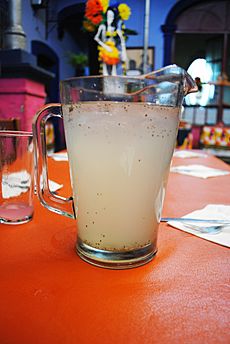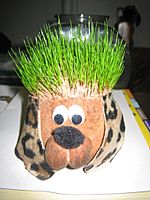Chia seed facts for kids
Chia seeds are the edible seeds of Salvia hispanica, a flowering plant in the mint family (Lamiaceae) native to central and southern Mexico, or of the related Salvia columbariae of the southwestern United States and Mexico. Chia seeds are oval and gray with black and white spots, having a diameter around 2 millimetres (0.08 in). The seeds are hydrophilic, absorbing up to 12 times their weight in liquid when soaked and developing a mucilaginous coating that gives chia-based foods and beverages a distinctive gel texture.
There is evidence that the crop was widely cultivated by the Aztecs in pre-Columbian times and was a staple food for Mesoamerican cultures. Chia seeds are cultivated on a small scale in their ancestral homeland of central Mexico and Guatemala and commercially throughout Central and South America.
Contents
Description
Typically, chia seeds are small flattened ovals measuring on average 2.1 mm × 1.3 mm × 0.8 mm (0.08 in × 0.05 in × 0.03 in), with an average weight of 1.3 mg (0.020 gr) per seed. They are mottle-colored with brown, gray, black, and white. The seeds are hydrophilic, absorbing up to 12 times their weight in liquid when soaked; they develop a mucilaginous coating that gives them a gel texture. Chia (or chian or chien) has mostly been identified as Salvia hispanica L. Other plants referred to as "chia" include "golden chia" (Salvia columbariae). The seeds of Salvia columbariae are used for food.
In the 21st century, chia is grown and consumed commercially in its native Mexico and Guatemala, as well as Bolivia, Argentina, Ecuador, Nicaragua, and Australia. New patented varieties of chia have been developed in Kentucky for cultivation in northern latitudes of the United States.
Seed yield varies depending on cultivars, mode of cultivation, and growing conditions by geographic region. For example, commercial fields in Argentina and Colombia vary in yield range from 450 to 1,250 kg/ha (400 to 1,120 lb/acre). A small-scale study with three cultivars grown in the inter-Andean valleys of Ecuador produced yields up to 2,300 kg/ha (2,100 lb/acre), indicating that favorable growing environment and cultivar interacted to produce such high yields.[20] Genotype has a larger effect on yield than on protein content, oil content, fatty acid composition, or phenolic compounds, whereas high temperature reduces oil content and degree of unsaturation, and raises protein content.
| Nutritional value per 100 g (3.5 oz) | |
|---|---|
| Energy | 486 kcal (2,030 kJ) |
|
42.1 g
|
|
| Dietary fiber | 34.4 g |
|
30.7 g
|
|
|
Protein
|
16.5 g
|
| Vitamins | Quantity
%DV†
|
| Vitamin A equiv. |
7%
54 μg |
| Thiamine (B1) |
54%
0.62 mg |
| Riboflavin (B2) |
14%
0.17 mg |
| Niacin (B3) |
55%
8.83 mg |
| Folate (B9) |
12%
49 μg |
| Vitamin C |
2%
1.6 mg |
| Vitamin E |
3%
0.5 mg |
| Minerals | Quantity
%DV†
|
| Calcium |
63%
631 mg |
| Iron |
59%
7.7 mg |
| Magnesium |
94%
335 mg |
| Manganese |
130%
2.72 mg |
| Phosphorus |
123%
860 mg |
| Potassium |
14%
407 mg |
| Zinc |
48%
4.6 mg |
| Other constituents | Quantity |
| Water | 5.8 g |
|
Link to USDA Database entry
|
|
| †Percentages estimated using US recommendations for adults. | |
History
The 16th-century Codex Mendoza provides evidence that it was cultivated by the Aztec in pre-Columbian times, and economic historians say it may have been as important as maize as a food crop. It was given as an annual tribute by the people to the rulers in 21 of the 38 Aztec provincial states. Chia seeds served as a staple food for the Nahuatl (Aztec) cultures. Jesuit chroniclers placed chia as the third-most important crop in the Aztec culture, behind only corn and beans, and ahead of amaranth. Offerings to the Aztec priesthood were often paid in chia seed.
Ground or whole chia seeds are used in Argentina, Bolivia, Guatemala, Mexico, and Paraguay for nutritious drinks and food. Today, chia is cultivated on a small scale in its ancestral homeland of central Mexico and Guatemala, and commercially in Argentina, Bolivia, Ecuador, Guatemala, and Mexico.
Nutrient content and food uses
Dried chia seeds contain 6% water, 42% carbohydrates, 16% protein, and 31% fat. In a 100-gram (3.5 oz) amount, chia seeds are a rich source (20% or more of the Daily Value, DV) of the B vitamins, thiamin and niacin (54% and 59% DV, respectively), and a moderate source of riboflavin (14% DV) and folate (12% DV). Several dietary minerals are in rich content, including calcium, iron, magnesium, manganese, phosphorus, and zinc (all more than 20% DV; see table).
The fatty acids of chia seed oil are mainly unsaturated, with linoleic acid (17–26% of total fat) and linolenic acid (50–57%) as the major fats.
Chia seeds may be added to other foods as a topping or put into smoothies, breakfast cereals, energy bars, granola bars, yogurt, tortillas, and bread. In 2009, the European Union approved chia seeds as a novel food, allowing chia to be 5% of a bread product's total matter.
They also may be made into a gelatin-like substance or consumed raw. The gel from ground seeds may be used to replace the egg content in cakes while providing other nutrients, and is a common substitute in vegan baking.

Preliminary health research
Although preliminary research indicates potential health benefits from consuming chia seeds, this work remains sparse and inconclusive. In a 2015 systematic review, most of the studies did not demonstrate a statistically significant effect of chia seed consumption on cardiovascular risk factors in humans.
Mesoamerican usage

S. hispanica is described and pictured in the Mendoza Codex and the Florentine Codex, Aztec codices created between 1540 and 1585. Both describe and picture S. hispanica and its use by the Aztecs. The Mendoza Codex indicates that the plant was widely cultivated and given as tribute in 21 of the 38 Aztec provincial states. Economic historians suggest that it was a staple food that was used as widely as maize.
Aztec tribute records from the Mendoza Codex, Matrícula de Tributos, and the Matricula de Huexotzinco (1560), along with colonial cultivation reports and linguistic studies, detail the geographic location of the tributes and provide some geographic specificity to the main S. hispanica-growing regions. Most of the provinces grew the plant, except for areas of lowland coastal tropics and desert. The traditional area of cultivation was in a distinct area that covered parts of north-central Mexico, south to Nicaragua. A second and separate area of cultivation, apparently pre-Columbian, was in southern Honduras and Nicaragua.
European usage
Chia is legally considered a novel food in Europe as it does not have "a significant history of consumption within the European Union before 15 May 1997", according to the Advisory Committee of Novel Foods and Processes. In 2009, permission was given to include small amounts of chia in bread products and a consumption limit of 15 g (1⁄2 oz) a day of packaged chia seed was suggested.
Research
Chia seeds are under preliminary research for their potential effects on health, but this work remains sparse and inconclusive.
Uses
Food
Chia seeds may be sprinkled whole or ground up on top of other foods. They can also be mixed into smoothies, breakfast cereals, energy bars, granola bars, yogurt, tortillas, and bread. They can be soaked in water and consumed directly or mixed with any kind of juice to make chia fresca or with milk. Chia seed pudding, similar to tapioca pudding, is made with a type of milk, sweetener, and whole chia seeds. Seeds may also be ground and made into a gelatin-like substance or eaten raw. The gel from ground seeds may be used to replace as much as 25% of the egg and oil content in cakes.
In 2009, the European Union approved chia seeds as a novel food, allowing chia to be up to 5% of the total matter in bread products.[11]
Unlike flax seeds, whole chia seeds do not need to be ground because the seed coat is delicate and readily digested, possibly improving nutrient bioavailability.
Chia pet
Joe Pedott created the Chia Pet in 1977 and marketed it widely after 1982. During the 1980s in the United States, the first substantial wave of chia seed sales was tied to chia pets, clay figures that serve as the base for a sticky paste of chia seeds. After the figures are watered, the seeds sprout into a form suggesting a fur covering.
About 500,000 chia pets were sold in the U.S. in 2007 as novelties or house plants.





